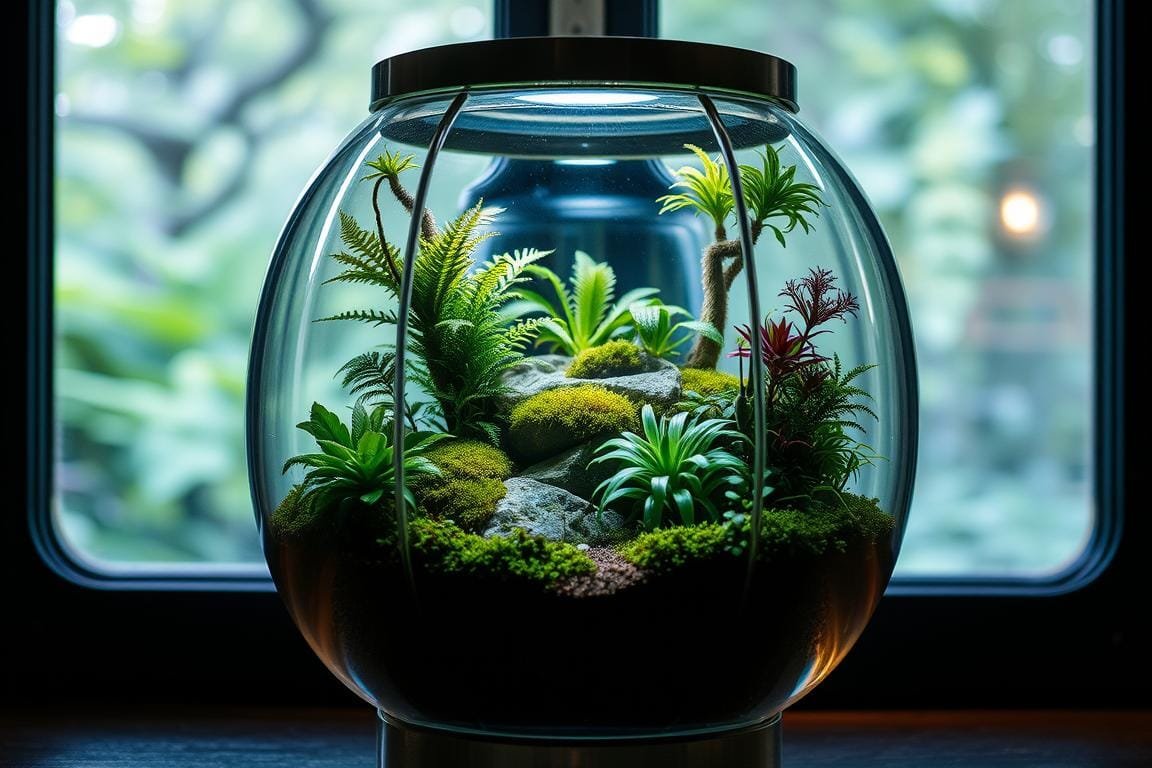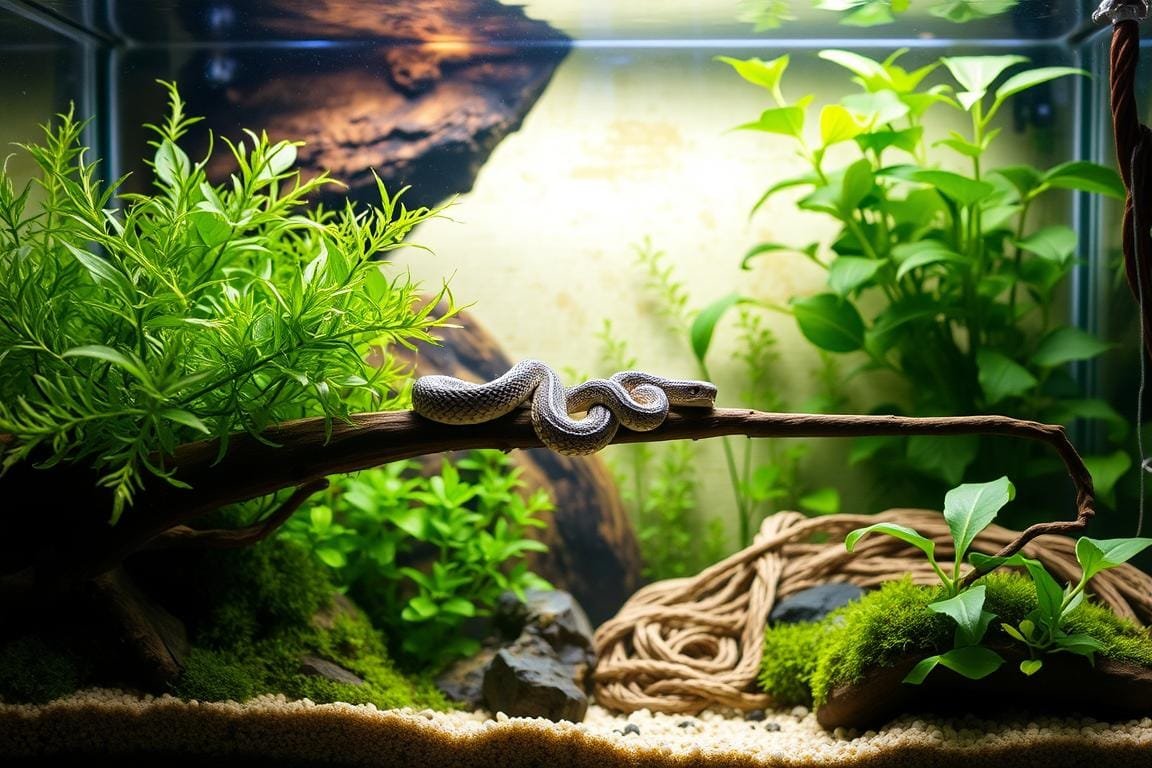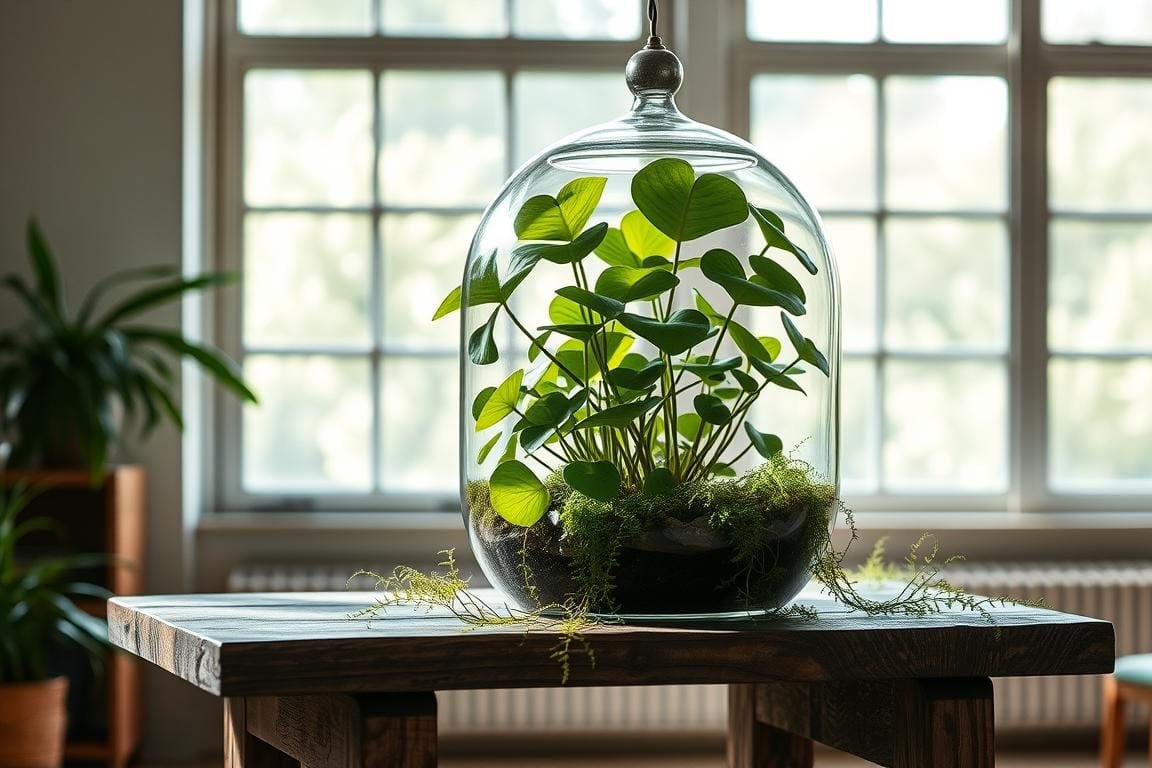Imagine a tiny world inside glass that thrives for decades with almost no human help. These self-sustaining ecosystems capture nature’s magic in miniature form, blending science and beauty into one captivating display.
One famous example is David Latimer’s bottle garden experiment, started in 1960. His sealed plants have flourished for over 60 years using just sunlight and recycled air and water. This project shows how balance and simplicity can create lasting life in a closed environment.
What makes these setups unique? They recycle moisture through condensation and reuse nutrients from decaying matter. Light fuels photosynthesis, while oxygen levels stay stable through natural exchanges. It’s like having a tiny rainforest on your shelf!
In this guide, you’ll learn to build your own low-maintenance garden at home. We’ll cover container choices, soil blends, and ideal light conditions. You’ll discover how to mimic nature’s cycles so your creation can thrive for years with minimal care.
The Story Behind a Timeless Glass Garden
In 1960, David Latimer sparked curiosity by planting spiderwort seeds in a 10-gallon glass bottle. His simple experiment became a living lesson in sustainability. Using compost, water, and sunlight, he created a sealed world that still thrives today.
David Latimer’s Sealed Bottle Experiment
Latimer added measured compost and water to his glass container, then closed it tightly. The setup was opened just once in 1972 to add water. Since then, this self-sustaining ecosystem has recycled air and moisture naturally. Spiderwort plants grew lushly, using decayed leaves to fuel new growth.
Nature’s Original Closed Ecosystem
This sealed garden mirrors Earth’s carbon and water cycles. Sunlight drives photosynthesis, while bacteria break down dead matter. The bottle’s size mattered—too small, and balance fails. Too large, and light can’t reach all plants.
Modern DIY ecosystems borrow Latimer’s approach. His work shows how sealed environments minimize maintenance while maximizing life. Schools use such projects to teach nutrient cycles and environmental science. It’s proof that nature, given the right tools, thrives on its own terms.
Understanding a Self-Sustaining Ecosystem
A sealed glass environment thrives through nature’s perfect loops—evaporation feeding rain, leaves producing air, and soil renewing itself. These processes work together like clockwork, creating a miniature world that needs little human help. Let’s break down how these invisible systems keep your garden alive for decades.
Water Cycle, Photosynthesis, and Respiration
Moisture rises from the soil and plant leaves, condensing on the glass like morning dew. This water drips back down, hydrating roots without manual watering. Meanwhile, photosynthesis turns sunlight into energy. Plants absorb carbon dioxide and release fresh oxygen, while roots and microbes breathe in that oxygen at night. It’s a daily dance of give-and-take.
Nutrient Recycling and Moisture Balance
Dead leaves and stems break down naturally, releasing nutrients back into the environment. Tiny organisms in the soil transform this decaying matter into plant food. Key factors for success include:
- Choosing slow-growing plants that match the container’s size
- Balancing light exposure to prevent overheating
- Using layered gravel and charcoal for drainage
Master these cycles, and your DIY project becomes a living lesson in Earth’s clever design. The right balance lets your tiny world sustain itself, just like nature intended.
Crafting Your Longest Living Terrarium

Building a self-sustaining ecosystem starts with smart material choices. Follow these steps to create a balanced glass container habitat that mirrors nature’s efficiency. Success lies in matching container size to plant needs and using layered organic materials.
Selecting the Ideal Glass Container and Soil
Choose clear, wide-mouthed jars or bottles for easy access. David Latimer’s 10-gallon bottle worked because it allowed light penetration and air circulation. Avoid colored glass—it blocks essential sunlight.
Start with a 1-inch gravel base for drainage. Add activated charcoal to filter impurities. Top with back soil mixed with coconut coir for moisture retention. This combo prevents root rot while delivering nutrients.
Choosing the Best Plants for a Sealed Environment
Slow-growing species like spiderwort or ferns excel in closed ecosystems. These plants adapt to limited space and recycle air efficiently. Avoid succulents—they crave dry conditions unsuitable for humid setups.
For a thriving self-sustaining terrarium, balance is key. Use 2-3 small plants per quart of container space. Trim overgrowth to maintain light access and prevent mold. With proper planning, your DIY terrarium becomes a low-maintenance marvel that outlives ordinary houseplants.
Essential Conditions for a Thriving Terrarium

Creating a healthy glass garden hinges on three key factors: light, moisture, and airflow. Like Earth’s natural ecosystems, these elements work together to sustain life through balanced processes. David Latimer’s iconic bottle garden thrived for decades by mastering this delicate equilibrium—proof that careful setup beats constant tinkering.
Managing Light, Humidity, and Temperature
Bright, indirect light fuels photosynthesis without overheating your glass container. Place it near an east-facing window or 3-5 feet from artificial grow lights. Too much direct sun? Leaves may scorch. Too little? Growth slows.
Condensation on the walls signals healthy moisture cycles. Wipe excess water if droplets persist for hours—this prevents mold. Maintain 65-75°F temperatures for optimal plant health. Avoid radiators or drafty areas that disrupt humidity.
Preventing Mold and Other Common Pitfalls
Closed environments rarely need watering, but decaying leaves can invite fungus. Remove dead material promptly and ensure proper soil drainage. Latimer’s sealed setup succeeded because microbes broke down waste efficiently, recycling nutrients naturally.
Monitor weekly for:
- Yellowing foliage (often too much water)
- White fuzz on soil (improve air circulation)
- Musty odors (temporarily open the lid)
For detailed terrarium care guidelines, focus on mimicking nature’s cycles. A well-balanced system reuses carbon dioxide, water, and organic matter—just like our planet does on a grand scale.
Exploring the Beauty and Legacy of Indoor Ecosystems
Indoor glass gardens do more than decorate—they teach. These tiny worlds let us watch nature’s processes unfold, from water droplets forming on glass to roots absorbing nutrients. Schools and hobbyists use them to demonstrate ecological balance, making complex concepts like photosynthesis tangible for all ages.
Educational Benefits and Environmental Inspiration
David Latimer called his bottle garden a “silent teacher.” Students observing such setups see how carbon dioxide becomes oxygen and how decay feeds new plant growth. These lessons extend beyond classrooms—terrariums in offices or homes spark conversations about Earth’s fragile ecosystems.
Urban dwellers especially connect with these mini-gardens. They’re living proof that nature thrives in small spaces, even without yards. Studies show caring for indoor plants reduces stress while fostering environmental awareness.
| Process | Terrarium | Earth |
|---|---|---|
| Water Cycle | Condensation on glass | Raincloud formation |
| Photosynthesis | Leaves producing oxygen | Forests cleaning air |
| Nutrient Recycling | Decaying leaves as fertilizer | Composting systems |
Want to start? Place a DIY glass habitat on a desk or shelf. Use native mosses or ferns to discuss local environments. These projects become heirlooms, passing ecological wisdom through years. As Latimer proved, even simple setups can inspire big changes in how we view our planet’s life systems.
Closing Reflections on Your Miniature Green World
Crafting a miniature ecosystem teaches patience and respect for nature’s rhythms. David Latimer’s bottle garden, thriving since 1960, shows how simple setups can become living legacies. His sealed experiment reshaped how we view self-sustaining ecosystems—proving that balance beats constant tinkering.
Your glass habitat mirrors Earth’s cycles. Choose slow-growing plants suited to your container’s space, layer soil and gravel wisely, and trust natural processes. Challenges like excess moisture aren’t failures—they’re chances to refine your approach. Mold? Adjust airflow. Condensation? Observe how water cycles through leaves and glass.
Every thriving sealed terrarium is a tiny classroom. Photosynthesis turns carbon dioxide into oxygen. Decaying leaves feed new growth. These micro-worlds remind us that life persists through give-and-take.
Share your DIY journey online. Did ferns flourish? Did moss thrive? Each success—or lesson—adds to this green tradition. Like Latimer’s iconic bottle, your creation isn’t just decor. It’s proof that nature, given the right balance, writes its own enduring story.





